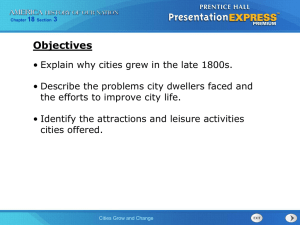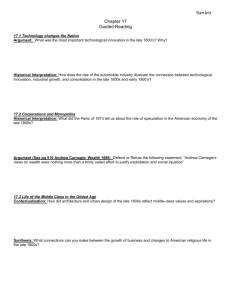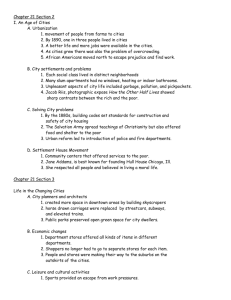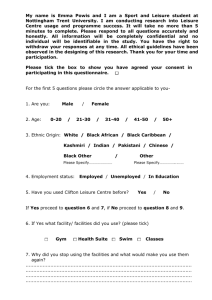22.3 Daily Life in the Late 1800s
advertisement
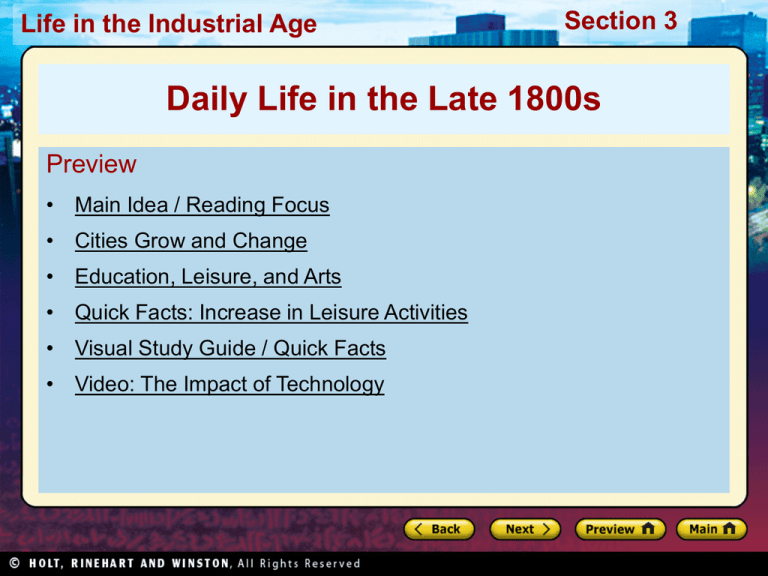
Life in the Industrial Age Section 3 Daily Life in the Late 1800s Preview • Main Idea / Reading Focus • Cities Grow and Change • Education, Leisure, and Arts • Quick Facts: Increase in Leisure Activities • Visual Study Guide / Quick Facts • Video: The Impact of Technology Life in the Industrial Age Section 3 Daily Life in the Late 1800s Main Idea During the late 1800s, cities grew and changed, while education, leisure time activities, and the arts reflected those changing times. Reading Focus • How did cities grow and change in the late 1800s? • What developments affected education, leisure, and the arts? Life in the Industrial Age Section 3 Cities Grow and Change Signs of changes during the Industrial Age • New activities like reading by electric light and riding bicycles • Many changes took place in the cities – Throughout 1800s much of Europe and the U.S. experienced urbanization, growth in the proportion of people living in towns and cities – Not only did cities grow, underwent transformation Section 3 Life in the Industrial Age Cities Grow and Change The Industrial City • Before Industrial Age most cities served trade, political, military, religious functions • In industrial city, new functions arose centered around manufacturing, distributing goods • Industrial city needed factories, workforce, reliable transportation, warehouses, stores, offices Industrial Cities • Lowell, Massachusetts, one of first industrial cities • Textile factories there employed young women from surrounding countryside • Chicago’s meat-packing industries lured workers there • Pittsburgh, Pennsylvania, attracted workers to the steel industry Life in the Industrial Age Section 3 Lively, fast-paced cities • Constant stream of pedestrians, electric streetcars, horse-drawn carriages all competed for space on streets • Merchants shouted prices from doorways • Construction crews constantly at work on banks, office buildings, homes Health concerns • Health of many residents suffered due to high population density • Smoky air from coal running steam engines and warming homes • London had problem with smoke combined with fog, term smog coined • 1873 smog episode caused 268 deaths Section 3 Life in the Industrial Age Cities Grow and Change Migration to Cities • • • • • People kept moving to cities in late 1800s despite unhealthy conditions Wanted jobs, also to escape hunger, political oppression or discrimination Many moved from native countries to cities in different lands Many Europeans sailed to Latin America, Australia, other places United States attracted the most people America Cities of Immigrants • 12 million immigrated to U.S. between 1870 and 1900 • 42 percent of New Yorkers foreignborn in 1890 • Came from Ireland, England, Germany, Italy, Russia, China • Immigrants also poured into Boston, Chicago, San Francisco • Most lived in miserable, crowded conditions when they first arrived • Newcomers gradually created their own unique neighborhoods Life in the Industrial Age Section 3 Cities Grow and Change The Livable City • Reforms eased squalid conditions, improvements made in infrastructure • Cities modernized their water and wastewater systems • Sanitation and overall health improved as a result Electricity • Made homemaking more convenient • Vacuum cleaners, refrigerators, electric stoves became available Working and Living Space Scarce • Constructing taller buildings became a solution • Architect Jenney designed first multi-story skyscraper, Chicago 1883 • Four years later, high speed elevator perfected and skyscapers could grow Life in the Industrial Age Section 3 Cities Grow and Change Congestion on Streets • Underground railway systems helped relieve crowding • World’s first subway line opened, London 1863 • Budapest opened subway in 1896 so residents could get to a city park easily Green Spaces • City planners made effort to preserve green spaces in cities • Gave working people places for healthy recreation • As cities became more congested, their boundaries expanded Suburbs • People moved out of cities to new areas that were less crowded • Public transportation like streetcars and ferries helped suburbs grow • Later suburbs developed along rail and bus lines Life in the Industrial Age Section 3 Identify Cause and Effect Why did people migrate to cities? Answer(s): to work in factories Section 3 Life in the Industrial Age Education, Leisure, and Arts With the growth of cities in the 1800s, new educational opportunities developed. In addition, new sports, other leisure activities, and changes in the arts world affected society. Education Support Not All Equal • Industrialization created need for more educated workforce • People supported public education to develop informed, patriotic citizens • Lower class children in school only as long as law required • Military leaders wanted officers who knew more about the world • Governments passed laws requiring education for all children • Vocational and technical training schools offered opportunities for working class Life in the Industrial Age Section 3 Education, Leisure, and Arts Education lagged behind for girls as it did for the lower classes • Some countries did not require girls go beyond elementary school grades • Few girls in high schools took science and math • Few colleges allowed women to enroll • Some educators thought women should have more opportunities, founded colleges just for women Life in the Industrial Age Section 3 Education, Leisure, and Arts With a more educated populace, more cities began printing newspapers. Expanded Coverage New Technology • Included not only current events, but arts and sciences • Innovations, linotype and electric press • Weekly installments of stories to keep readers coming back • Improved newspaper printing process • Political cartoons poked fun at public figures • Reporting of foreign affairs improved with telegraph • Newspapers had specific viewpoints • Readers could find one which identified with their views • Journalism profession began to grow Life in the Industrial Age Section 3 Education, Leisure, and Arts Leisure time Railroads • More time to play, watch sports • Growth meant sports fans could travel to see teams play • British football, American football, rugby developed • Baseball became popular during Civil War Cultural activities • New concert halls and theaters built by governments • More orchestras, bands, choral groups evolved • Public funding lowered ticket prices • Allowed more families to enjoy range of activities • Traveled to vacation spots Art • Moved from private homes • Museums made great works available to all • Public libraries also opened Life in the Industrial Age Section 3 Section 3 Life in the Industrial Age Changes in the Arts With all the discoveries, inventions and new ideas of the 1800s, it is no wonder that the world of arts underwent change as well. Artists, writers, and musicians developed new styles in response to what was going on around them. Literary and Artistic Change • Romanticism, with emphasis on intuition and feeling • Reaction to early abuses of Industrial Revolution • Love of nature, deep emotions, value of individual, affection for past, importance of imagination Romantics of the Time • William Wordsworth, expressed romantic spirit in poetry • Ludwig von Beethoven’s music celebrated human freedom Theodore Gericault, romantic painter with scenes of suffering heroes In the mid-1800s, a movement known as realism developed in reaction to romanticism. Life in the Industrial Age Section 3 Changes in the Arts Realism • Revealed the details of everyday life, no matter how unpleasant • Charles Dickens wrote about struggles of London’s poor • Pollution, exploitation, miseries of industrialization were other themes Other Voices • Russian writer Leo Tolstoy showed war as chaotic, horrible in War and Peace • Norwegian Henrik Ibsen revealed unfair treatment of women, A Doll’s House Realism in Art • Painters turned to realism as reaction against romanticism • Painted ordinary working people as they really lived • Many paintings show lower classes possessing quiet dignity Life in the Industrial Age Section 3 Changes in the Arts A new way of looking at the world • 1860s, group of French painters introduced impressionism • Wanted to capture impression of a scene using light, vivid color, motion • Did not want to show all realistic details Life in the Industrial Age Section 3 Find the Main Idea How did the arts reflect how people viewed the world in the 1800s? Answer(s): The arts reflected the struggle between the ways of the past and the new inventions of the Industrial Age. Life in the Industrial Age Section 3 Section 3 Life in the Industrial Age Video The Impact of Technology Click above to play the video.

